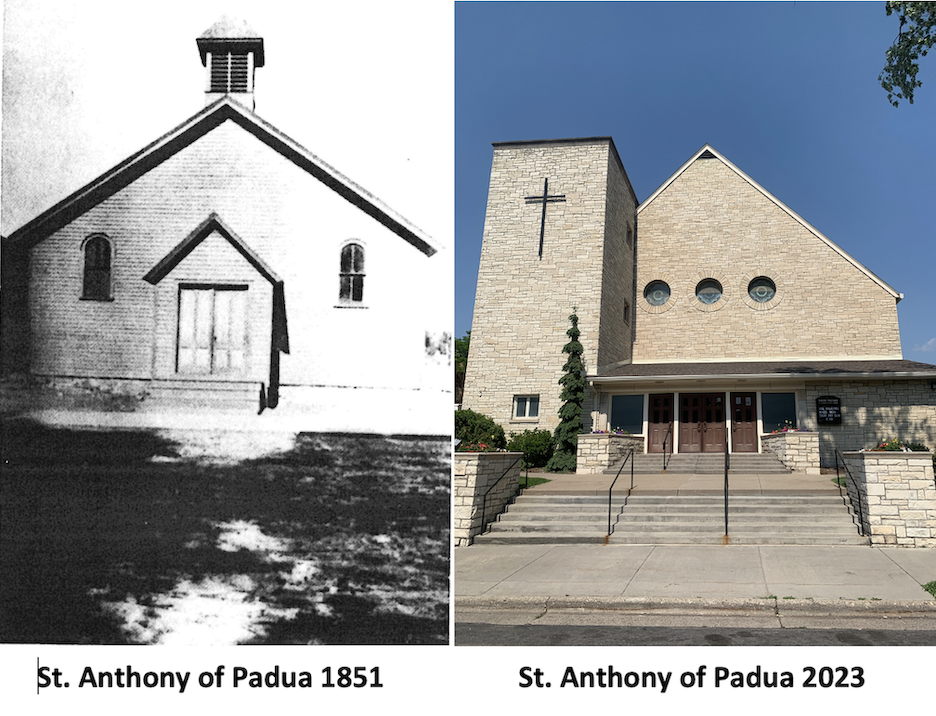St Anthony of Padua

St. Anthony of Padua
A light of faith, loyalty, and dedication in Northeast
“The life of the body is the soul; the life of the soul is God.”
- Saint Anthony of Padua
St. Anthony of Padua has been a light of Catholic faith in Northeast Minneapolis for more than
150 years, and Catholic Eldercare is blessed to have this historical place of worship on our campus.
The territorial parish, named for St. Anthony of Padua, grew out of an early mission established in 1849 by Father Augustine Ravoux, a French missionary who played an important role in the early days of the diocese of Saint Paul. As Father Ravoux traveled up and down the Mississippi and Minnesota Rivers, he saw a need for a Catholic church for many French-Canadian and European immigrants who had settled in the area around St. Anthony Falls. In 1849, Father Ravoux began building a church as a mission station served by the French missionary priests stationed in Mendota. It was completed in 1851.
14 lots of land were donated by Pierre Bottineau and three other donations of one and a half acres each for the building of a Catholic church. This land would also become the site of the parish school. The Sisters of St. Joseph arrived from St. Louis in 1853 to run St. Anthony of Padua Parish School, housed in St. Anthony of Padua Church. The school was supported by the parish.
The settlement of St. Anthony Falls, which came to be known as St. Anthony was named for its proximity to the Falls discovered and named by Father Hennepin, and it was a land of promise. The 1840’s and 1850’s were a boom period, and when the first territorial legislature selected
St. Anthony as the site of a future Minnesota University, the area grew. Referenced in the earliest newspapers of the time as “upper town,” the thriving community became Northeast Minneapolis.
Bishop Cretin came to the new Diocese of St. Paul in 1851 as its first bishop. He recognized the need for a permanent pastorate and Catholic school, so he appointed Father D. Ledon, also a French missionary priest, as the first pastor of St. Anthony of Padua. Financial difficulties had always harassed the early pioneers, but Father Ledon succeeded in completing the little frame church begun by Father Ravoux. One of the first events noted in the parish record book was the October 1852 wedding of Severe Bottineau, Pierre’s older brother, to Julie Chènevert, with William Dugos and “Peter” Boutineau as witnesses.
Father Fayolle was the second pastor of St. Anthony of Padua, and he set out to build a church made of stone, but financial difficulties and illness slowed construction. When Father McDermott became the third pastor of the parish in 1860, he completed the stone church that had been the dream of his two predecessors and Father Ravoux. All the stone is said to have come from neighboring quarries.
The stone church was dedicated by Bishop Cretin in 1861, on the site where it now stands as the “Mother Church of the Lakes” of Minneapolis. At this time, the old frame church was moved to the corner of 2nd Street and 8th Avenue. Along with an old store building, procured by Father McDermott, both structures were used as a school for some years.
In 1986, Fr. Felix Tissot finished construction of a larger stone church. And in 1898, after growth within the parish, two brick towers were added to the church façade.
By the end of the century, the St. Anthony parish block was graced by four buildings, the church on Mainstreet, the parish rectory on 9th Avenue, midway between Main and 2nd Street, and the two school buildings facing 2nd Street. As the predominantly French, German, and Irish neighborhood changed, St. Anthony of Padua later served a largely Irish American congregation. Over the years, residents of this parish community grew deep loyalties to their faith, church, school, country, and to each other. These loyalties are the foundation of the resurrection of Catholic Eldercare by founders who grew up in Northeast with values that were cultivated over generations.
St. Anthony of Padua has gone through several alterations, especially in its façade, but the body of the Church is identical with the 1861 structure. The church was in need of major work following WWII. A two-year renovation, completed in 1948 by Fr. Francis Lang, installed the modern oak altar still in place as well as a New Bedford stone façade, restoring the look of its original appearance. This last alteration is said to have restored the church to its original architectural plan.
On July 1, 2013, Catholic Eldercare purchased the St. Anthony of Padua Church building. We are proud and honored to have been entrusted with the stewardship of this historic structure. As the spiritual cornerstone of the Albert J. Hofstede Campus, it holds over 150 years of Northeast Minneapolis Catholic history. It is also home to the neighborhood’s beloved shrine of Our Lady of Perpetual Help as well as Catholic Eldercare’s beautiful St. Anthony Garden.
St. Anthony of Padua holds a sacred place where many come to worship, pray and reflect, and continues to be loved by Northeast residents within our community and beyond. Our goal is to ensure that the former parish church remains at the center of our community’s life in service to the spiritual needs of our clients, their families and our neighbors.
Some of the content of this article was taken from a sketch written by Sister Antonine O’Brien, C.S.J. with material gathered from the archives of St. Anthony Parish, St. Anthony School, The archives of St. Paul Seminary, and
The History of the Sisters of St. Joseph, St. Paul Province by Sister Helen Angela Hurley.